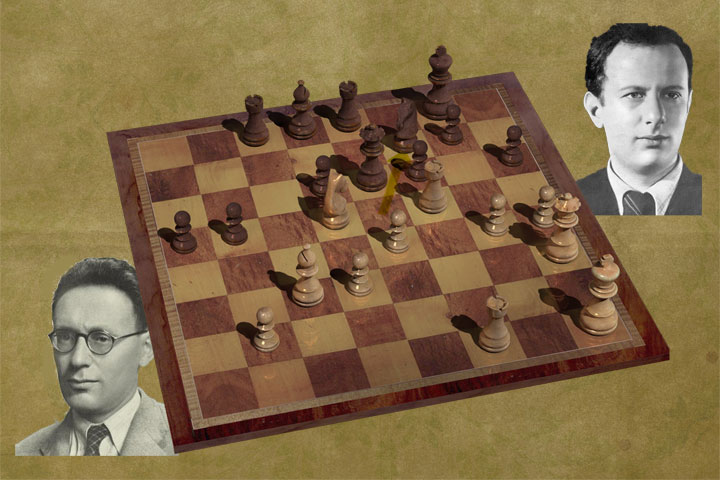Born in 1911 near Saint Petersburg, Botvinnik learned the game at the age of twelve – in our day, players are already becoming grandmasters at that age! He progressed rapidly and by the age of twenty, he was already among the leading players in the Soviet Union.
From 1936, when he tied for first place at the Nottingham tournament (with Capablanca), Botvinnik established himself as one of the world’s elite. The war interrupted his efforts to organize a World Championship match, and after the war, with World Champion Alekhine’s death in 1946, FIDE organized the 1948 World Championship tournament. Botvinnik won it convincingly, outclassing all his opponents in their mini-matches and demonstrating his extraordinary strength.
He would hold the World Championship title until 1963, with the exceptions of 1957 and 1960, when Smyslov and Tal, respectively, temporarily wrested it from him. Even after permanently losing the title in 1963 to Petrosian in a match, Botvinnik continued to achieve excellent results until he finally retired from active tournament play in 1970.
Botvinnik is widely regarded as the founder of the scientific approach to chess. Generations of chess players have learned from his creative legacy: from his games and from his deep, meticulously precise annotations, which reveal the inner content of his play. He regularly annotated his games for a wide audience in various periodicals and books. In fact, among his principles for player preparation was the belief that every major player should publish their own annotated games.
He last annotated his most important games in his monumental work Analytical and Critical Works (Moscow, 1984–1987), in three volumes (with a fourth volume containing his articles and various analyses). Since then, much time has passed. Chess has undergone an unprecedented expansion thanks to the Internet; computers and engines have become an integral part of the game (Botvinnik himself was one of the first to work on chess algorithms). Consequently, some of his commentary has inevitably become outdated. More recently, Alexander Khalifman published a collection of Botvinnik’s selected games, but this included only those that the author himself considered most significant.
It is well known that classical games remain one of the best ways to learn chess. This is confirmed, directly or indirectly, by Garry Kasparov in his monumental five-volume work My Great Predecessors, in which he analyzes the work of all the great players (in his view) up to his own era. The analysis of great masters’ games shows us the paths along which chess has developed, and from the classics we can learn a great deal about every phase of the game. Naturally, Botvinnik’s oeuvre is no exception. He was, after all, affectionately nicknamed The Patriarch of Chess.
The subject of this article is a game Botvinnik played in 1943 (while World War II was still raging) against one of the great hopes of Soviet chess at the time — and a true innovator — Isaac Boleslavsky. In 1950, Boleslavsky would share first place in the Candidates Tournament, only to lose a playoff match to Bronstein, thus missing the opportunity to challenge for the world title.
Botvinnik annotated this game in several sources, to my knowledge, for the first time in his 1949 collection of selected games, and for the last time in volume two of Analytical and Critical Works (Moscow, 1985).
Early in the game, Botvinnik sacrificed a pawn and maintained a positional initiative throughout. We are particularly interested in the position after 29.Bxf6. Botvinnik awarded this move an exclamation mark in all his annotations, regarding it as a decisive blow and asserting that his position was winning.
But was he correct?
We invite our readers to help us unravel this riddle: Was Botvinnik right in his evaluation? Furthermore, did both sides play accurately until the end, or were there hidden mistakes?
The game soon transposes into the fascinating and theoretically significant material balance of queen versus two rooks. Understanding the play in this game can help us deepen our comprehension of such positions.
We therefore invite our readers to explore this part of our game, and contribute their own analyses — to uncover the truth about this Botvinnik game and, in doing so, to fill a small gap in our understanding of his analytical legacy.
Here’s the game in a ChessaBase replayer, where you can analyse with an engine and add your notes. The game can then be downloaded as a PGN, which you can send to us.
